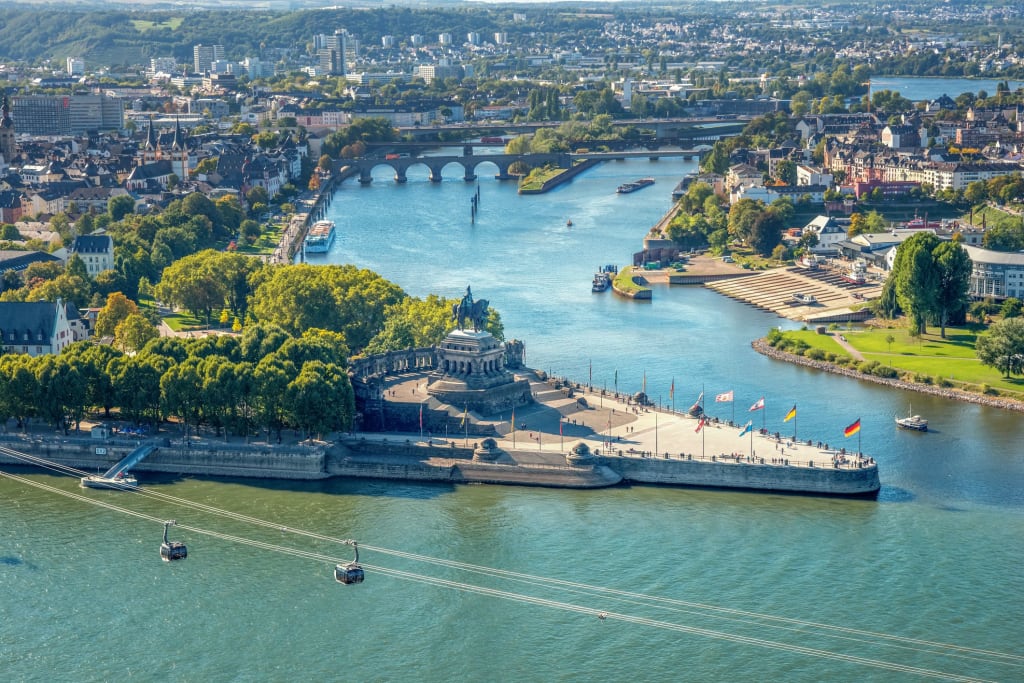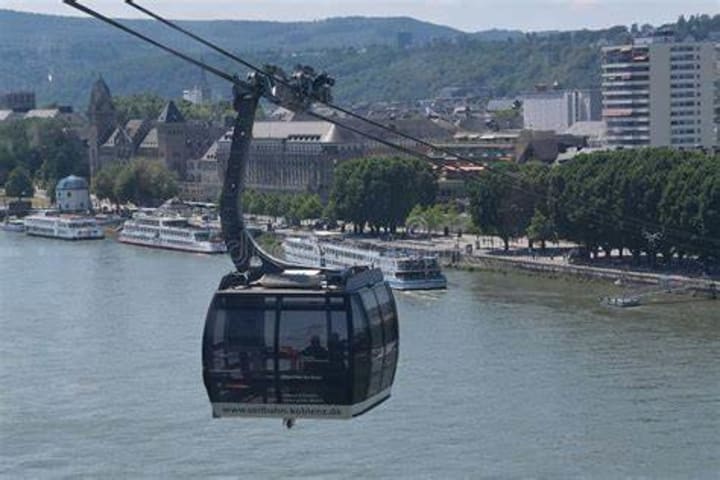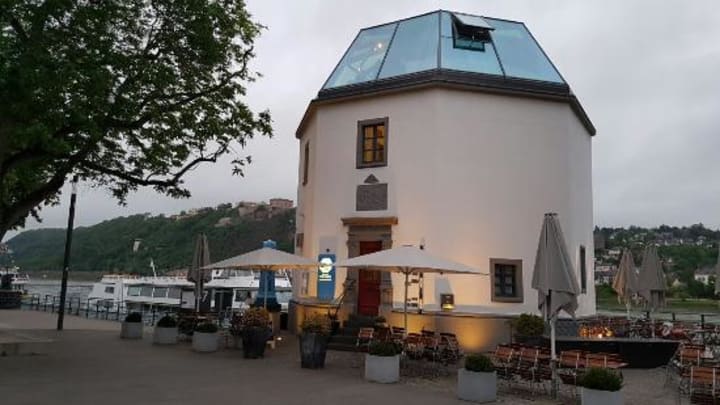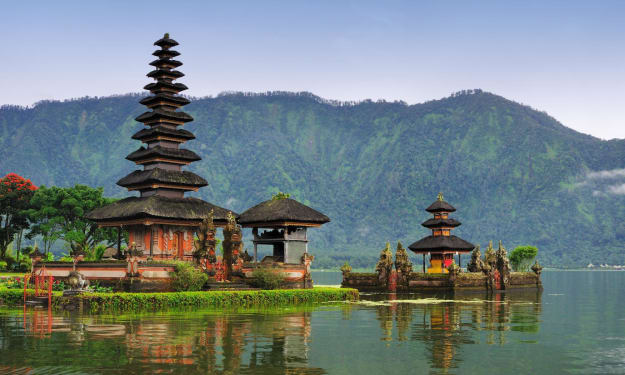Koblenz on the Rhine and Moselle Rivers
A beautiful town in Germany

The town of Koblenz is located in a lovely, picturesque setting of the landscape of the Rhine and Moselland. This 2000-year-old town is surrounded by four low mountain ranges. There are many cultural monuments, historic buildings, and river promenades for strolling.

The Deutsches Eck or German Corner is a spit of land at the confluence of the Rhine and Moselle Rivers. It was named by the Teutonic Order of Knights when they settled here in 1216. A monument to Kaiser Wilhelm I was built, commemorating the unification of the German Empire. Destroyed during the war this monument was reconstructed in 1993. The monument stands 37 meters high and attracts over 2 million visitors annually. Since 2002 it has been part of the Upper Middle Rhine Valley UNESCO World Heritage site.

Ehrenbreitstein Fortress stands 118 meters high over the Rhine. From the fortress, you can get fantastic views of Koblenz, the surrounding vineyards, and the confluence of the Rhine and Moselle Rivers. This is the second-largest preserved fortress in Europe and was built between 1817 and 1828. Its origins date back to 1000 AD. It is open to the public along with some excavation parts.

Visitors can take a breathtaking ride up to the fortress by aerial cable car. The cable car measures about 850 meters and can carry 7,600 visitors per hour. This cable car is one of the largest of its type in Europe outside of the Alps. It was built for the National Garden Show in 2011. 18 cable cars offer awesome views of the Upper Middle Rhine Valley.

A masterpiece and an important symbol of Romanticism on the Rhine is Stolzenfels Castle. Visitors can see the gate building, Gothic residential tower, main castle building with the vaulted banqueting hall, and pergola gardens. Some parts of the castle feature furniture, paintings, and sculptures that date from the 16th to the 18th century. In the banqueting hall, you can see a collection of historical weapons and flags. Other highlights include wall paintings in the chapel.

One of the oldest and most magnificent cultural landscapes in all of Europe is the Upper Middle Rhine Valley. The valley is considered to be the epitome of Romanticism on the Rhine. This is a section of land about 65 kilometers located between Koblenz and the towns of Bingen and Rudesheim. In 2002 it was awarded UNESCO World Heritage Site status. Here you can find wonderful castles and fortresses.

Forum Confluentes is an arts and cultural center. It is home to the Middle Rhine Museum which displays information about the history of the city. Exhibitions include Middle Rhineland sculptures from the 13th to the 16th centuries and paintings from the Baroque and Romantic periods. Visitors can also enjoy the Romanticum which is an interactive display offering a virtual cruise along the beautiful Middle Rhine Valley. On site is also the main Tourist Information Center in the city with a large model that highlights the main tourist attractions.

The Ludwig Museum is located in the Deutschherrenhaus. It was the first settlement of the Teutonic Order of Knights in Rhineland. The building faces the Kaiser Monument, a memorial to Wilhelm I. The museum offers a collection of artwork.

Alte Brug is a 12th-century castle standing on the banks of the Moselle. It was once home to the Electors of Trier while they struggled to subject locals to their rule. The castle is surrounded by a tall wall with some parts dating back to Roman times and a wide moat which is fed by the Moselle. The castle is home to the Municipal Archives and Library. In the Langemarck Barracks visitors can see a collection of small arms, cannons, uniforms, and vehicles.

The Balduin Bridge was built by Archbishop and Elector Balduin in 1337. It once had 14 arches but today has 11. Some parts of the bridge are still on wooden piles.

There is a stone statue that commemorates the archbishop.

The Old Town center of Koblenz was restored after WW II.

Among the highlights is the Town Hall that was built between 1695 and 1700.

The Schangel Fountain stands in front of the Town Hall. It was designed by Carl Burger in 1940. The fountain is dedicated to poet Josef Cornelius, who wrote the lyrics to the “hymn” for the city.

Florinsmarkt is home to the Romanesque and Gothic 12th-century Florinskirche.

The Romanesque Liebfrauenkirche or Church of Our Lady was built in the 12th century with additions in the 15th century. Among the highlights here are the Gothic choir and the Baroque Towers. The towers have four bells which toll the “Reveler's Bell” every evening at 10 PM.

On the banks of the Rhine, you'll find the Weindorf or Wine Village. It has been producing good wine and regional specialties for almost 75 years. The complex has a genuine vineyard and half-timber houses that come from the most famous German wine-growing areas. The village was built for the German Wine Exhibition in 1925.

Pegelhaus or Gauge House is among the many landmarks in the city. Originally it housed a crane and later on a water-level gauge. Today it is a popular restaurant, the start of the Rhine Gardens, and a ferry and local boat jetty.

Lovely Rhine Gardens includes a promenade and walkways on the east bank of the Rhine.
Among the highlights are:

The Plaffendorf Bridge

The neo-Classical Electoral Palace is located below the bridge. It was completed in 1786 by the last Electro of Trier, Clemens Wenzeslaus. The palace was built to blend in with the riverside landscape. The public galleries host art exhibits and the old gardens have been incorporated into the Gardens of the Empress Augusta.

The Gardens of Empress Augusta with tree-lined pathways, sculpture gardens, and colorful flower beds.

There is a large statue of Father Rhine and Mother Mosel, a 19th-century monument that celebrates Koblenz as the meeting place of the two most important rivers in the region.

Basilica of St. Castor was founded in 836 AD. This is the place where the historic Treaty of Verdun was signed in 843. Among the highlights here are the Dwarf Gallery with 21 arches and images of Christ as a lion, old tombs, and a 20th-century war memorial.
About the Creator
Rasma Raisters
My passions are writing and creating poetry. I write for several sites online and have four themed blogs on Wordpress. Please follow me on Twitter.






Comments
There are no comments for this story
Be the first to respond and start the conversation.